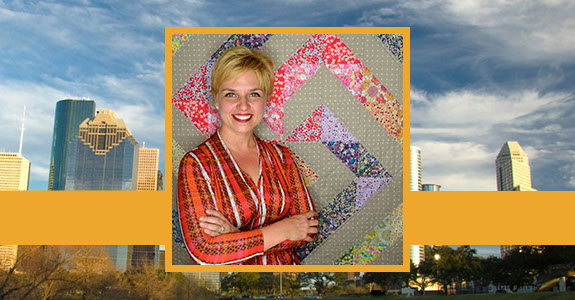
Q&A – HEATHER KUBIAK
For nearly 20 years, Houston-based lawyer Heather Kubiak as been advising, mediating, and litigating for her business clients in commercial disputes. In 2013, the Texas Bar Foundation named her a Sustaining Fellow, and she speaks and writes frequently on intellectual property topics.
But when she is not practicing law, she is secretly...quilting!
Kubiak will be combining her two great interests at the upcoming Quilt Market in Houston where she’ll be teaching two Business Seminars: “Introduction to Patents, Trademarks, and Copyright Laws” (event #200, Fri., Oct. 27, 8-10 a.m.) and “Legal and Practical Tips for Running a Successful Business” (event #500, Mon., Oct. 30, 8-10 a.m.).
For this issue of eInsider, we talked to Kubiak about the rule of law when it comes to art, how the internet has changed practices, and…the biggest mistake that artists make today.
eINSIDER: How did you get involved in teaching seminars at Quilt Market?
KUBIAK: As an avid quilter and crafter, I feel connected to our community. I have been writing and teaching seminars for lawyers since the beginning of my career. I have a passion for teaching and mentoring others.
Then, about four years ago, I started attending Quilt Market. I heard industry professionals talking to each other about copyright law, and much of it was based on myths or other misinformation. The same day, I introduced myself to [Market Founder] Karey Bresenhan to find out how I could help inform and clarify intellectual property issues. The rest is history!
-------------------------------------------------------------------------------------------------
eINSIDER: What is the biggest mistake that you see artists make in terms of trademark, copyright, and patent protection?
KUBIAK: Most disputes in our industry arise from confusion and misunderstanding about the extent of copyright protection.
For the public, some may assume that they have the right to use creations however they wish. For example, if they buy a pattern, many assume that means that the pattern purchaser can make as many objects as they want. Artists can eliminate this confusion entirely by clearly expressing how their creations can be used, and by providing contact information for additional information. Annette Unrein at ByAnnie.com has a wonderful example of this.
On the artists’ side, some assume copyright protection on creations that are not copyrightable. For example, information, ideas and processes are not copyrightable—patents protect this type of intellectual property. However, the text and illustrations for this information can be.
As an example: Say that I attend a class taught by Sue Nickels at International Quilt Festival. She provides a handout in the class containing her method for appliqué, including small details about stitch length. I cannot reproduce her materials and give them away without her permission. However, nothing stops me from teaching this exact method to others. Morally, I believe I should tell my students that I was lucky enough to learn this method from Sue Nickels, but the law does not require me to do so.
-------------------------------------------------------------------------------------------------
eINSIDER: Do quilters have any specific concerns/challenges in this area that perhaps other visual artists don’t?
KUBIAK: Most definitely! Copyright law does not protect “useful objects.” Our community understands that quilts can be art in its purest form. However, I wonder what a jury would think? Many of my friends and family think that quilts are just to put on beds and keep you warm!
-------------------------------------------------------------------------------------------------
eINSIDER: How has the internet—and the proliferation of images on it —impacted artist’s copyright issues?
KUBIAK: Artists face a difficult choice. The moment the creation is put into tangible form, the artist has copyright protection. However, copyright protection alone does not further the artist’s career or make the artist any money. The way to monetize a creation these days is to share it on social media or on the internet.
Social media websites require you to agree to their terms and conditions before using the site. Those terms and conditions usually confer a license to use your images to other users of the website. As of the date of this writing, for example, Facebook addresses this very subject in your privacy and application settings.
If you post something on Facebook, you have given anyone who can see it permission to use it, because you have entered into a binding contract with Facebook. The other social media sites have similar terms and conditions so that they can protect themselves from costly intellectual property lawsuits. Artists should at least watermark their photo and videos so that someone cannot take credit for their work.
-------------------------------------------------------------------------------------------------
eINSIDER: What do you hope people take away most from your seminars?
KUBIAK: That copyright law is perhaps the murkiest area of the law. Most courts cannot agree on bright line rules with respect to applying copyright protection. Therefore, with respect to copyrights, I hope to provide my students with a framework to analyze their own copyright issues.
Most importantly, I want to encourage our artists to work together! Litigation expense rarely makes sense between individuals or small companies. Litigation is often fueled by miscommunication and hurt feelings. If you are moved by someone else’s work, get in touch with them! It has been my experience that quilters want to share their ideas and works, and it provides both people an opportunity to make a connection.
-------------------------------------------------------------------------------------------------
eINSIDER: Any other comments?
KUBIAK: Don’t rely on information about copyrights from non-legal contributors. In researching for this class, I have come across a number of commentators on copyrights and sewing who have put out information that is outright wrong!
For more information about these issues, visit The Kubiak Law Firm’s blog at www.thekubiaklawfirm.com, or the U.S. Copyright Office’s website at www.copyright.gov under the “law and guidance” tab.
UPCOMING SHOWS
2017
International Quilt Market/Houston
October 28-30
Classes begin October 27
George R. Brown Convention Center
Houston, Texas, USA
International Quilt Festival/Houston
November 2-5
Preview Night November 1
Classes begin October 30
George R. Brown Convention Center
Houston, Texas, USA
International Quilt Market/Portland
May 18-20
Oregon Convention Center
Portland, Oregon, USA
International Quilt Market/Houston
November 3-5 (NOTE LATER DATES)
Classes begin November 1
George R. Brown Convention Center
Houston, Texas, USA
NOTE: Quilt Market is a credentialed
trade show only, and not open to
the public.
For information on these or any other Quilts, Inc. shows, visit www.quilts.com
2018
Subscribe to our eInsider Newsletter
©Quintessential Quilt Media, 2017. All rights reserved.
7660 Woodway
Suite 550
Houston, Texas 77063
U.S.A.
Telephone (1) 713.781.6864
Fax (1) 713.781.8182
e-mail: shows@quilts.com

News and Trends from International Quilt Market
